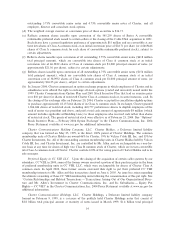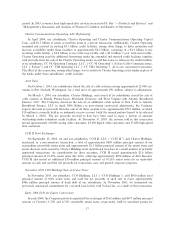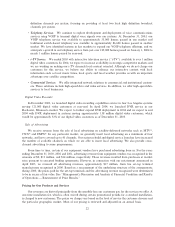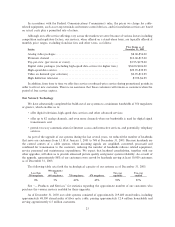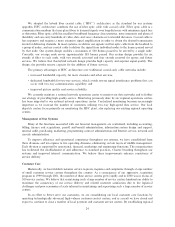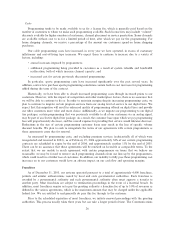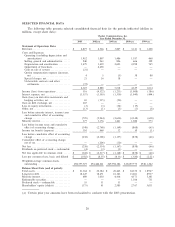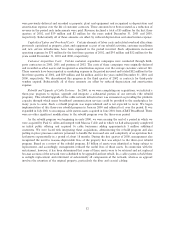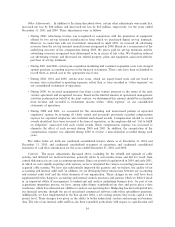Charter 2003 Annual Report Download - page 26
Download and view the complete annual report
Please find page 26 of the 2003 Charter annual report below. You can navigate through the pages in the report by either clicking on the pages listed below, or by using the keyword search tool below to find specific information within the annual report.We adopted the hybrid Ñber coaxial cable (""HFC'') architecture as the standard for our systems
upgrades. HFC architecture combines the use of Ñber optic cable with coaxial cable. Fiber optic cable is a
communication medium that uses glass Ñbers to transmit signals over long distances with minimum signal loss
or distortion. Fiber optic cable has excellent broadband frequency characteristics, noise immunity and physical
durability and can carry hundreds of video, data and voice channels over extended distances. Coaxial cable is
less expensive and requires a more extensive signal ampliÑcation in order to obtain the desired transmission
levels for delivering channels. In most systems, we deliver our signals via Ñber optic cable from the headend to
a group of nodes, and use coaxial cable to deliver the signal from individual nodes to the homes passed served
by that node. Our system design enables a maximum of 500 homes passed to be served by a single node.
Currently, our average node serves approximately 385 homes passed. Our system design provides for six
strands of Ñber to each node, with two strands activated and four strands reserved for spares and future
services. We believe that this hybrid network design provides high capacity and superior signal quality. The
design also provides reserve capacity for the addition of future services.
The primary advantages of HFC architecture over traditional coaxial-only cable networks include:
‚ increased bandwidth capacity, for more channels and other services;
‚ dedicated bandwidth for two-way services, which avoids reverse signal interference problems that can
occur with two-way communication capability; and
‚ improved picture quality and service reliability.
We currently maintain a national network operations center to monitor our data networks and to further
our strategy of providing high quality service. Monitoring previously done by our regional operations centers
has been migrated to our national network operations center. Centralized monitoring becomes increasingly
important as we increase the number of customers utilizing two-way high-speed data service. Our local
dispatch centers focus primarily on monitoring the HFC plant, also replacing our existing regional operating
centers.
Management of Our Systems
Many of the functions associated with our Ñnancial management are centralized, including accounting,
billing, Ñnance and acquisitions, payroll and beneÑt administration, information system design and support,
internal audit, purchasing, marketing, programming contract administration and Internet service, network and
circuits administration.
To improve eÇciency and operational consistency throughout our systems, we have consolidated from
three divisions and ten regions to Ñve operating divisions, eliminating certain layers of middle management.
Each division is supported by operational, Ñnancial, marketing and engineering functions. The reorganization
has facilitated the establishment of and adherence to standard practices, Charter branding throughout our
systems and improved internal communication. We believe these improvements enhance consistency of
service delivery.
Customer Care
Historically, we have Ñelded customer service requests, inquiries and complaints through a large number
of small customer service centers throughout the country. As a consequence of our aggressive acquisition
program in 1999 through 2001, the number of these service centers grew rapidly and in 2000 was in excess of
300 service centers. We believe that maintaining such a large number of service centers hindered our ability to
maximize the consistency of our service delivery and related customer satisfaction due to the logistical
challenges and poor economies of scale inherent in maintaining and supervising such a large number of service
centers.
In an eÅort to better serve our customers, we are consolidating our local customer care functions by
operating technologically advanced, high-volume customer contact centers, and as a result we have closed and
expect to continue to close a number of local payment and customer service centers. By establishing regional
24


